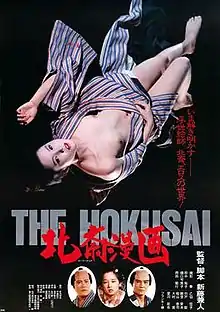| Edo Porn | |
|---|---|
 | |
| Directed by | Kaneto Shindō |
| Written by | Kaneto Shindō |
| Based on |
|
| Produced by |
|
| Starring | |
| Cinematography | Keiji Maruyama |
| Edited by | Yoshi Sugihara |
| Music by | Hikaru Hayashi |
Production company | |
| Distributed by |
|
Release date | |
Running time | 119 minutes |
| Country | Japan |
| Language | Japanese |
Edo Porn (Japanese: 北斎漫画, romanized: Hokusai manga) is a 1981 Japanese biographical drama film written and directed by Kaneto Shindō. It is based on Seiichi Yashiro's stage play on the life of Japanese artist Hokusai.[1][2][3]
Plot
Tetsuzō is an unsuccessful ukiyo-e (woodblock) painter who lives in poverty with his daughter Ōei over a geta shop owned by Ōyaku, the older wife of the aspirant writer Sashichi, who is a childhood friend of Tetsuzō.
Tetsuzō lives by borrowing money from his adoptive father, mirror-maker Nakajima Ise. One day, he meets a young, beautiful prostitute named Ōnao and becomes fascinated with her. He produces a series of drawings of her, but later leaves her to Nakajima as a concubine. Ōnao, a sadist with a traumatic past, psychologically torments Nakajima until he hangs himself, and leaves.
After Ōyaku dies, Sashichi, adopting the pen name Bakin, devotes his life to writing and ignores Ōei's advances who has intimate feelings for him. Nevertheless, Ōei continues to love him, withdrawing to celibacy.
Years later and after hard-earned fame, Tetsuzō (now Hokusai) is 89. He lives by painting Ichimatsu dolls with Ōei. One day, Ōei finds a peasant girl who looks like Ōnao. After he sees a young ama (pearl diver) playing with a dead octopus, Hokusai persuades the girl to pose for the shunga (erotic art) of an ama engaged in a threesome with two octopuses.
Cast
- Ken Ogata as Tetsuzō (Hokusai)
- Toshiyuki Nishida as Sashichi (Bakin)
- Yūko Tanaka as Ōei
- Kanako Higuchi as Ōnao / peasant girl
- Frankie Sakai as Nakajima Ise
- Nobuko Otowa as Ōyaku
- Yoichi Sase as Gosuke
- Taiji Tonoyama as the woodcarver
- Joe Shishido as Jippensha Ikku
- Kon Omura as Shikitei Sanba
- Kinya Aikawa as Utamaro
- Rokkō Toura as head clerk
- Hideo Kanze as Kanō Torukawa
- Kunio Otsuka as Tsutaya Jūzaburō
Awards
- Blue Ribbon Award[4] and Japan Academy Film Prize[3] for Best Supporting Actress Yūko Tanaka
References
- 1 2 "北斎漫画". Kinema Junpo (in Japanese). Retrieved 27 December 2020.
- 1 2 "北斎漫画". Japanese Movie Database (in Japanese). Retrieved 27 December 2020.
- 1 2 "北斎漫画とは" (in Japanese). Kotobank. Retrieved 27 December 2020.
- ↑ "ブルーリボン賞ヒストリー". Cinema Hochi (in Japanese). Archived from the original on 7 February 2009. Retrieved 19 August 2023.
External links